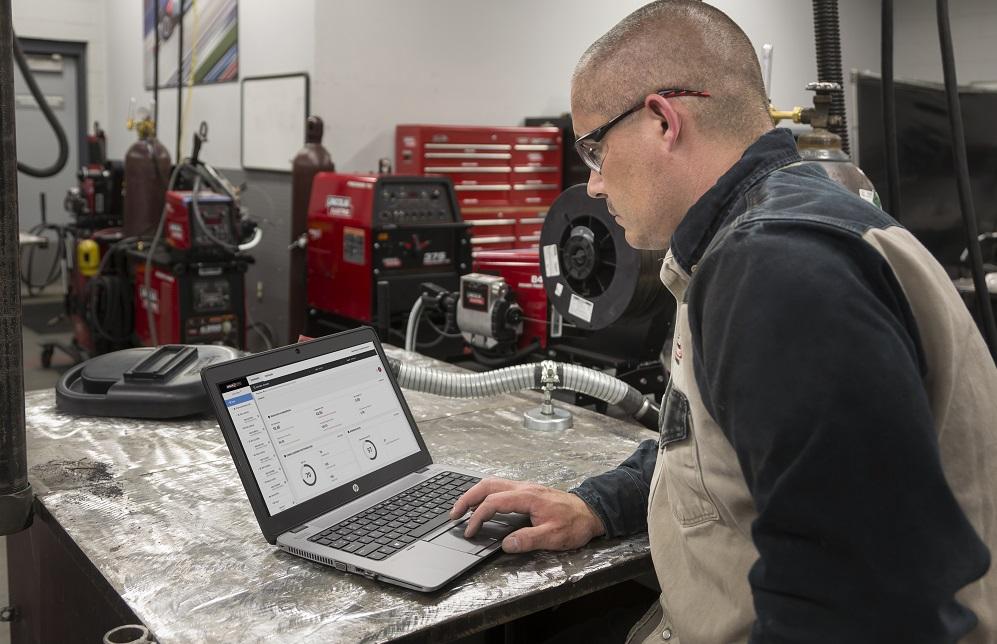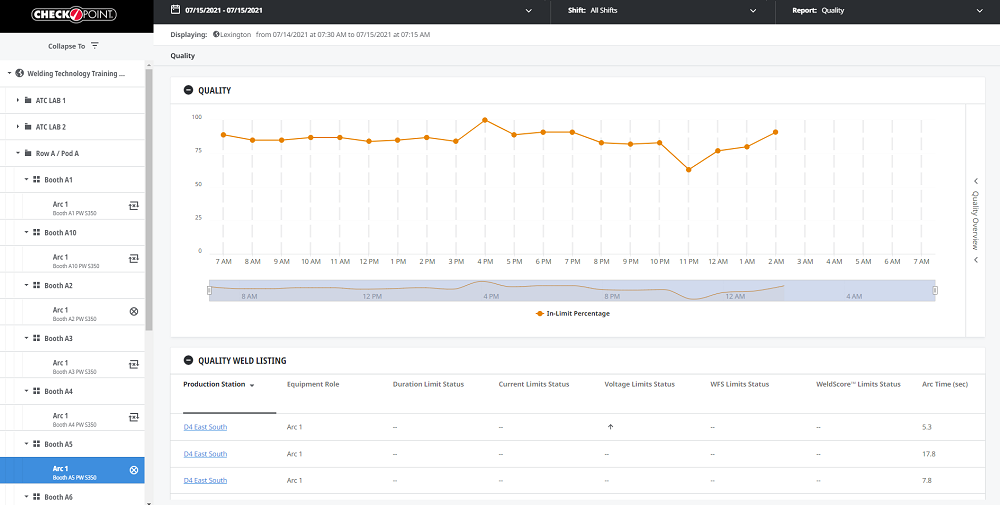Director - Advanced Technology Products
- FMA
- The Fabricator
- FABTECH
- Canadian Metalworking
Categories
- Additive Manufacturing
- Aluminum Welding
- Arc Welding
- Assembly and Joining
- Automation and Robotics
- Bending and Forming
- Consumables
- Cutting and Weld Prep
- Electric Vehicles
- En Español
- Finishing
- Hydroforming
- Laser Cutting
- Laser Welding
- Machining
- Manufacturing Software
- Materials Handling
- Metals/Materials
- Oxyfuel Cutting
- Plasma Cutting
- Power Tools
- Punching and Other Holemaking
- Roll Forming
- Safety
- Sawing
- Shearing
- Shop Management
- Testing and Measuring
- Tube and Pipe Fabrication
- Tube and Pipe Production
- Waterjet Cutting
Industry Directory
Webcasts
Podcasts
FAB 40
Advertise
Subscribe
Account Login
Search
IoT in welding: How it can improve your shop
Industry 4.0 and next-generation GMAW production monitoring applications
- By Gary Abke
- Updated January 19, 2024
- October 27, 2021
- Article
- Arc Welding

Modern production monitoring systems help to transform large amounts of essential weld data into clean, interactive dashboards, charts, and graphs that simplify how weld data is visualized. Images: Lincoln Electric
The way fab shops harness the power of welding and specifically GMAW production data has changed dramatically over the past decade.
As Industry 4.0 trends shift from just fancy buzzwords to an expected part of remaining competitive, the Industrial Internet of Things (IIoT) has continued to marry smart technology with traditional manufacturing processes.
Today’s technology has made it easier than ever to deliver machine connectivity and real-time data across an organization, its employees, processes, and products. These changes are pushing fabricators to new digital heights on the shop floor, the back office, and the C-suite.
Industry 4.0 and Data-Driven Weld Monitoring
Data has always been a crucial part of welding, but in this era of Industry 4.0 and Industrial IoT, data has become an even more powerful tool that will continue to evolve. It solves problems, drives decisions, contributes to profitability, and helps welding personnel pinpoint slowdowns or other problem areas on the welding line.
Manual data quickly becomes overwhelming, and collecting it is time-consuming. Often too much data is out there for your organization to manually sift through, analyze, and put into action.
So, how do you streamline this data overload and turn raw information into actionable intel that you can use for your operation’s benefit to help increase productivity, quality, and return on investment? Today’s data-driven world demands a more digital approach, one that operates seamlessly through the IIoT.
When the first generation of welding production monitoring software made its debut over 20 years ago, no one dreamed exactly how the digital world would influence all aspects of life, including manufacturing.
Back then the first generation of weld production monitoring systems were limited to very basic weld data, viewable only on a dedicated workstation in the shop. The cloud did not exist, at least not for most welding operations, and the data was available in simple, raw spreadsheets or manual reporting functions.
Beyond that, there were other challenges. The earliest production monitoring systems produced more data than any one operation could ever assess. Fabricators found themselves poring over raw weld data reports trying to discern what was useful and what was not. Significant amounts of time and brainpower were needed to transform this data into useful and actionable information.
However, like any technology, things have evolved markedly across multiple iterations of these production monitoring programs. Thank the lightning-fast pace of tech and Industry 4.0 for spurring change on the shop floor and in the welding booth, creating a culture of real-time visual data and connected workers and operations.

By capturing this real-time, at-the-weld data, you get full visibility to key productivity metrics such as arc-on time, wire deposition rates, operating factor, and overall equipment effectiveness.
How Present-Day Weld Data Monitoring Works
Digital data has reshaped manufacturing forever, including the welding line, whether it is a manual or automated application. The IIoT has given fabricators an easy way to monitor and analyze their welding operations by collecting real-time, point-of-weld data that can be visualized and accessed easily from anywhere on any device.
Why do shops like yours need this technology and access to vital real-time knowledge? It helps you visualize and uncover the truth behind two key considerations – performance and quality, not to mention return on investment.
Visual, real-time weld monitoring systems allow you to obtain point-of-weld data that is meaningful and actionable. The days of manipulating grueling spreadsheets and manual data-crunching are over. Modern production monitoring systems help to transform large amounts of essential weld data into clean, interactive dashboards, charts, and graphs that simplify how weld data is visualized.
In return, you can easily picture your entire welding operation -- from overall GMAW efficiency all the way down to each individual weld parameter -- in order to make smarter and faster data-driven decisions that impact productivity and quality.
How Data Monitoring Supports GMAW Productivity
Every manufacturing organization looks for ways to improve throughput and eliminate bottlenecks on the shop floor. Often it takes dedicated sleuthing to pinpoint where, how, and why a production line falters. Welding, whether manual or robotic, is not immune to this.
The latest iterations of weld data monitoring systems not only track and collect vital data, but they also help to automatically calculate and transform the data into key performance indicators (KPIs) that are specific to productivity in the welding industry.
Using weld data monitoring, you can easily identify from any mobile device or computer what welding stations are running, which operators are welding, and what weld parameters are being used. By capturing this real-time, at-the-weld data, you get full visibility to key productivity metrics such as arc-on time, wire deposition rates, operating factor, and overall equipment effectiveness.
All of these metrics can play a role in making or breaking your welding operation. Armed with this information from weld data monitoring tools, you can quickly visualize and resolve bottlenecks rather than spending time digging through raw data to figure out where things are out of sync.
A straightforward example of this is the common approach of aligning production goals with arc-on time. A weld data monitoring system can help automatically capture, calculate, and display instantaneous arc-on time for individual welders, or the production line as whole. This delivers actionable data for managers to see real-time throughput trends that are affecting productivity and efficiency and take proactive, data-driven action to adjust personnel or processes.
What Role Does Weld Data Monitoring Play in Quality Assurance?
While increased productivity can be a main driver of weld data monitoring, quality assurance can’t be left out of the conversation. Out-of-spec welding parameters and defective products have severe consequences to your bottom line. That is why checks and balances and a well-fabricated part play important roles in any manufacturing process. Weld data monitoring helps facilitate this process easier than manual quality tracking efforts.

The latest iterations of weld data monitoring systems not only track and collect vital data, but they also help to automatically calculate and transform the data into key performance indicators (KPIs) that are specific to productivity in the welding industry.
As quality standards and certifications become increasingly stringent across the manufacturing spectrum, it is becoming more common to ensure your operation has verification, tracking, and backup data to support QA claims. Weld data monitoring simplifies this process by gathering all of this valuable data at the source and providing a virtual paper trail of individual welds to identify the root of quality issues.
But that’s not all. Weld data monitoring platforms also might help you stop some quality issues before they happen by providing proactive monitoring to identify problems in real time. With modern weld data monitoring platforms, you have the ability to establish weld parameter limits that are automatically monitored and tracked. This can reduce the need to retroactively trace the weld process that resulted in a quality failure through data archives. You can set preventive measures in the system, including alerts, to ensure the system flags any deviations from the spec.
For example, if weld voltage parameter limits are set for a GMAW application, and a weld falls outside of that voltage limit, a station can be locked out and an email can be sent to an inspector in real time. In return, this can help identify a potential defective weld before it moves further down the manufacturing process and leads to costly rework or scrap.
Getting Started With IoT in Welding
If you’re feeling inspired and want to take the next step to get connected and use weld data, it’s not difficult to launch cloud-based weld data monitoring on the shop floor. Yes, you will need to work with your IT department to ensure you have the proper networking infrastructure, but thankfully, such infrastructure is common on today’s manufacturing floor.
As the world continues to grow increasingly digital, making the most of IIoT technology and production monitoring systems is crucial to competitive success. Today’s weld data monitoring platforms are focused on helping you improve your operations, boost overall efficiency, and take quality to an even higher level. And with these systems making it easier than ever to connect, capture, and visualize data, the question isn’t if you should start using weld data monitoring, but when.
About the Author
Gary Abke
22801 St. Clair Ave.
Cleveland, OH 44117
(216)-481-8100
About the Publication
subscribe now

The Welder, formerly known as Practical Welding Today, is a showcase of the real people who make the products we use and work with every day. This magazine has served the welding community in North America well for more than 20 years.
start your free subscription- Stay connected from anywhere

Easily access valuable industry resources now with full access to the digital edition of The Fabricator.

Easily access valuable industry resources now with full access to the digital edition of The Welder.

Easily access valuable industry resources now with full access to the digital edition of The Tube and Pipe Journal.
- Podcasting
- Podcast:
- The Fabricator Podcast
- Published:
- 04/16/2024
- Running Time:
- 63:29
In this episode of The Fabricator Podcast, Caleb Chamberlain, co-founder and CEO of OSH Cut, discusses his company’s...
- Trending Articles
Sheffield Forgemasters makes global leap in welding technology

Welding student from Utah to represent the U.S. at WorldSkills 2024

Lincoln Electric announces executive appointments

Engine-driven welding machines include integrated air compressors

ESAB unveils Texas facility renovation

- Industry Events
16th Annual Safety Conference
- April 30 - May 1, 2024
- Elgin,
Pipe and Tube Conference
- May 21 - 22, 2024
- Omaha, NE
World-Class Roll Forming Workshop
- June 5 - 6, 2024
- Louisville, KY
Advanced Laser Application Workshop
- June 25 - 27, 2024
- Novi, MI



























